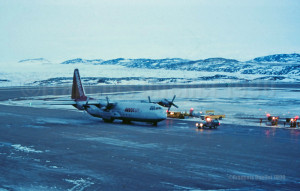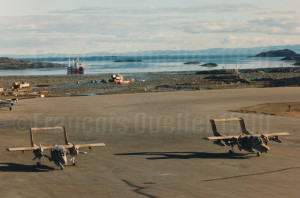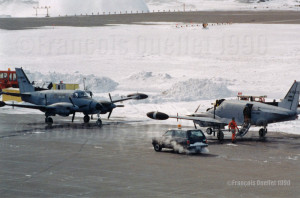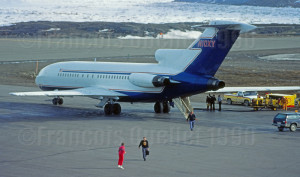In August 1990, Iraq invaded Kuwait. This invasion was unanimously condemned, even by countries that are traditionally aligned with Iraq. The United Nations reacted by giving Iraq up to January 15th 1991 to withdraw. But Saddam Hussein’s attitude clearly showed that there would be no withdrawal and that he intended to proceed with Kuwait annexation to the Iraqi territory.
Understanding that military force would obviously be necessary, United States (representing a coalition of 34 countries) started preparing for the conflict. Aircraft movements increased and short range military aircrafts that would have to cross the Atlantic used Iqaluit, on Baffin Island, as a stopover before continuing through Greenland, Iceland, Europe and finally the Middle East.
Starting summer 1990, the Iqaluit airport then became one of the mandatory stopovers towards Middle East for some military aircrafts. Soon we could see L-382s carrying large size items and some OV-10 Broncos painted with desert colors landing in Iqaluit. Later on during autumn, other specially equipped aircrafts like the U.S.Army RU-21 Guardrail Common Sensor also made stopovers in Iqaluit.
A Southern Air Transport L-382 also landed in Iqaluit. That company was sometimes used by the CIA for its operations.
As soon as a flight service specialist (FSS) was not busy with radio communications, he would head toward the briefing counter to receive the military pilots who had come to obtain the mandatory weather and flight planning information that would be used to safely cross the Atlantic.
HF frequencies used for international communications at the local Transport Canada flight service station were really busy. On top of the regular air traffic services normally associated with commercial aircrafts crossing the Atlantic, we were now dealing with the radio communications associated with numerous military cargo aircrafts like the C-5s Galaxy and others.
In the two weeks preceding the United Nations ultimatum, between January 1st and 15th 1991, the Iqaluit flight service station recorded a 266 % increase against the same period in 1990 in oceanic traffic transiting through its airport. Flights were mostly related with private or chartered business jets linked to international banks, petroleum companies and military organizations preparing for the events to come. We received, among others, aircraft types like the G1, G2, G3, G4, HS25, DA50, DA90, CL60, C550, LR25 and B-727.
One night of January 1991, while we were at work, one member of the staff took-off his headphones and calmly told me: “Son, the war has started”.
I will remember that special period since we did not receive a military training but, nonetheless, we witnessed and dealt with the preparation and aircraft movements associated with a major military conflict.
Moreover, for a short period, the Iqaluit airport reverted to the use it had initially been planned and built for in 1942, during the Second World War, which was a base created for short-range military aircrafts heading to Europe.
For more real life stories as a FSS in Iqaluit, click on the following link: Flight service specialist (FSS) in Iqaluit




